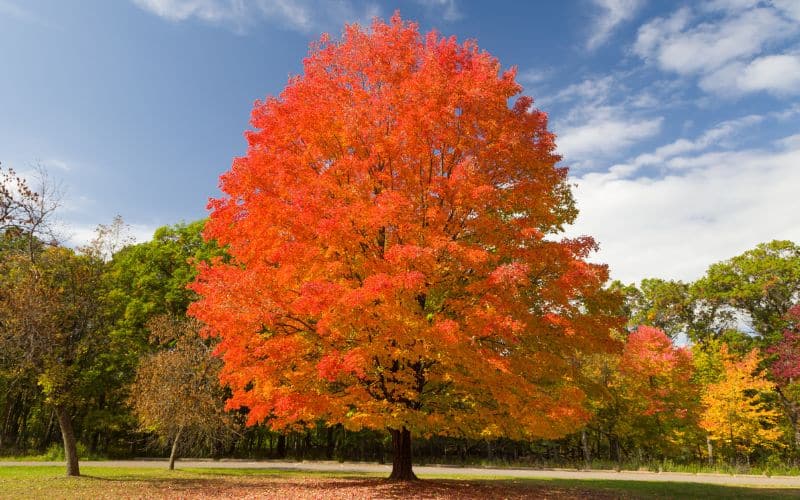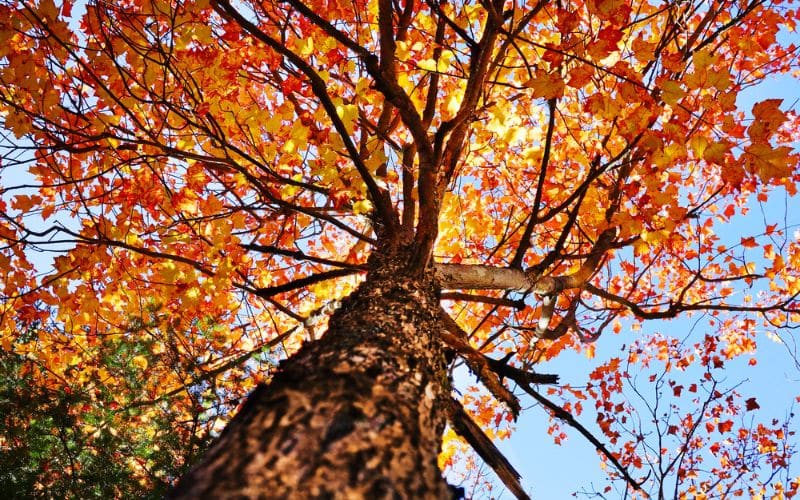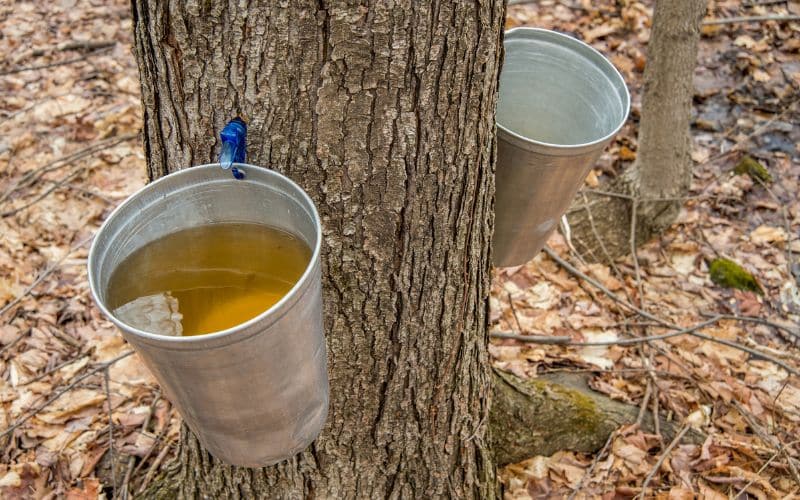
Why the Sugar Maple is More Than Just a Tree in Ontario
Picture this: a tree that’s not only a feast for the eyes but also a cornerstone of Canadian identity and a culinary delight. Meet the sugar maple, a tree that’s so much more than just wood and leaves. It’s the iconic leaf that graces our Canadian flag and the secret behind the heavenly maple syrup that elevates our pancakes from good to glorious. In Ontario, this tree—known to the science folks as Acer saccharum—holds a place of honor. So, let’s set off on an enlightening journey to discover the multifaceted roles and enduring allure of the sugar maple in Ontario’s vibrant tapestry of life.
What Makes Acer Saccharum Unique?
The sugar maple, or Acer saccharum if you’re into botanical names, is a standout in more ways than one. First, let’s talk about its dazzling autumn display. As the seasons shift, the sugar maple’s leaves undergo a magical transformation. They morph from a lush, summery green to a kaleidoscope of red, orange, and yellow hues. This vibrant colour palette not only makes for Instagram-worthy photos but also signals the tree’s unique ability to produce anthocyanins, the pigments responsible for these vivid shades.
But the sugar maple isn’t just a pretty face. Its wood is a hot commodity in various industries, especially in furniture making. Known for its fine grain and durability, sugar maple wood is a top choice for crafting everything from elegant dining tables to sturdy kitchen cabinets. And let’s not forget the sap—this tree is the primary source for authentic maple syrup, a liquid gold that has put Canada on the global culinary map.
Where in Ontario is the Sugar Maple Found?
The sugar maple is quite the cosmopolitan tree, making its home in a variety of settings across Ontario. From the deep, moist soils of the province’s lush forests to the manicured lawns of suburban neighborhoods, this tree knows how to adapt and thrive. It’s particularly fond of well-drained, slightly acidic to neutral soils, which allow it to reach its full height of up to 35 metres.
In the wild, you’ll often find sugar maples in mixed hardwood forests, sharing the canopy with other native species. They’re a common sight in conservation areas and national parks, where they play a vital role in the ecosystem. But they’re not just confined to rural landscapes; many Ontarians have embraced the sugar maple as a beloved addition to their gardens and public spaces, valuing it for its shade, beauty, and of course, the promise of homemade maple syrup.

How to Grow Your Own Sugar Maple
- Test the Soil: Start by testing your soil to ensure it’s well-drained and falls within a slightly acidic to neutral pH range. Soil testing kits are readily available and easy to use.
- Choose the Location: Find a spot in your yard that offers partial to full sun. Make sure there’s enough space for the tree to grow up to its full height of 35 metres without interfering with power lines or other structures.
- Planting Time: The best time to plant your sugar maple is during its dormant periods, either in late fall or early spring.
- Dig the Hole: Dig a hole that’s about twice the width of the root ball and as deep. This gives the roots room to spread.
- Place the Tree: Gently place the tree in the hole, making sure it’s standing straight. Fill the hole with soil and lightly tamp it down to remove air pockets.
- Water: Water the tree generously right after planting to help settle the soil.
- Ongoing Care: In the first few years, make sure to water the tree consistently, especially during dry spells.
- Monitor Growth: Keep an eye on your tree as it grows, and adjust your care routine as needed.
The Ministry of Natural Resources: Guardians of the Sugar Maple
When it comes to safeguarding the sugar maple, Ontario’s Ministry of Natural Resources is at the forefront. But their role goes beyond mere observation; they’re actively involved in the conservation and management of this native species. Through comprehensive monitoring programs, they assess the health of sugar maple populations, identifying any threats such as diseases or pests.
Their efforts don’t stop there. The Ministry also spearheads initiatives aimed at promoting the sustainable growth of the sugar maple. This includes educational campaigns to inform the public about best practices for tree care, as well as partnerships with local communities and organizations to plant more sugar maples and enhance their habitats.
In essence, the Ministry serves as the steward of the sugar maple, ensuring that this iconic tree continues to thrive and enrich Ontario’s diverse ecosystems.
Why is Acer Saccharum So Important to Ontario’s Ecosystem?
The sugar maple isn’t just a showstopper in the fall; it’s a workhorse in Ontario’s ecosystems year-round. Its shade-tolerant nature makes it a team player in the forest, allowing it to coexist harmoniously with other plant species. But it’s not just about providing shade; the sugar maple plays a vital role in soil health. Each year, its leaves fall to the ground, decomposing to release essential nutrients that enrich the soil. This natural process not only benefits the sugar maple itself but also nourishes the surrounding flora, creating a more robust and resilient ecosystem.
What Are the Challenges in Growing a Sugar Maple?
Growing a sugar maple may seem straightforward, but it comes with its own set of challenges. First and foremost is the soil condition. This tree is particular about its growing medium, preferring well-drained, slightly acidic to neutral soil. If the soil doesn’t meet these criteria, you may find your tree struggling to thrive.
Shade is another factor to consider. While the sugar maple is known for its shade tolerance, it does have its limits. The tree prefers a balanced environment where it can enjoy both shade and sun. Too much of either can stress the tree, affecting its growth and overall health.

What Products Can Be Made from Sugar Maple Trees?
The sugar maple is a veritable goldmine of resources, and it’s not just about that delectable maple syrup. Sure, the sap is the star ingredient in this iconic Canadian treat, but the tree’s utility extends far beyond the breakfast table.
The wood of the sugar maple is another prized asset. Known for its durability and fine grain, it’s a go-to material for high-quality furniture. Whether it’s a bespoke dining table or a handcrafted rocking chair, sugar maple wood adds a touch of elegance and longevity to any piece.
But let’s not overlook the seeds and fruit. While they may not be as famous as the sap or wood, they serve important ecological functions, such as providing food for wildlife and aiding in natural reforestation efforts.
In short, the sugar maple is a multi-talented tree, offering a range of products that enrich our lives in various ways, from culinary delights to functional and beautiful furnishings.
The Cultural Significance of Acer Saccharum in Ontario
The sugar maple leaf is more than just a botanical marvel; it’s a symbol deeply woven into the fabric of Canadian culture. It graces our national flag, serving as an emblem that unites Canadians from coast to coast. While it may not hold the official title of ‘national tree,’ its presence on the flag elevates it to an honorary status that’s hard to ignore.
But the cultural significance of the sugar maple extends beyond emblems and symbols. Its vibrant autumnal display of red, orange, and yellow leaves has become synonymous with the natural beauty of Canada, particularly Ontario. These stunning hues serve as an annual reminder of the country’s rich landscapes, inspiring artists, photographers, and nature lovers alike.
In essence, the sugar maple is not just a tree; it’s a living testament to Canadian identity and natural splendor, especially cherished in the heart of Ontario.
Conclusion: The Lasting Legacy of the Sugar Maple in Ontario
The sugar maple is a tree that wears many hats. It’s a provider of shade, a contributor to the soil, and a spectacle of colour in the fall. It’s the tree that gives us maple syrup and the leaf that represents us on the Canadian flag. It’s a native species that has found its place in the forests and backyards of Ontario, and its legacy is sure to continue for generations to come.
So the next time you see a sugar maple, take a moment to appreciate all that it brings to our lives—from its bark to its brilliant leaves, from its sap to its seeds. It’s a tree that truly defines what it means to be Canadian.








